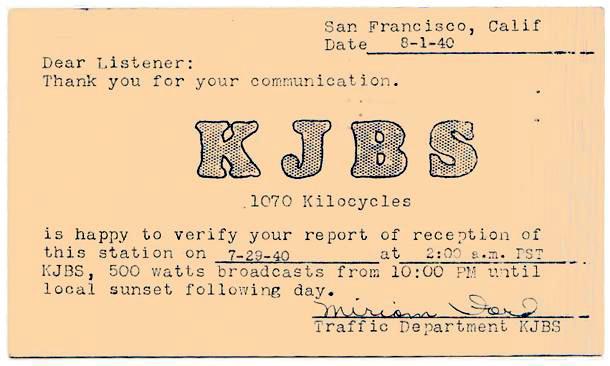

The History of KJBS Radio
San Francisco, California
By John F. Schneider
KJBS was San Francisco’s flea-powered station, but it quickly made a big name for itself as an alternative to the standard radio program fare.
The station came on the air on January 3 of 1925 as KFUQ, operated by the Willard Storage Battery Company in San Francisco. Within a month of going on the air, the owners changed the call letters (wouldn’t you?) to KJBS, which stood for Julius Brunton and Sons, operators of the shop.
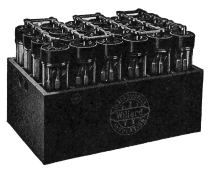
The Bruntons had not planned at first to enter the field of broadcasting. Their sudden introduction to it had come a year earlier, when they accepted an old amateur radio transmitter in lieu of payment on a debt. They first operated the transmitter as a ham station, 6RY, and powered it from a bank of storage batteries, which provided 600 volts of plate voltage to produce the meager output of five watts.
It was from this little operation that their interest grew, until they applied for a broadcast license the following year. The initial assignment was to 234 meters (1282 kc.), changing to 236 meters (1271 kc.) on March 27.
The station was located on the second floor of the shop at 1380 Bush Street, directly over the drive-in garage. It consisted of a control room, large and small studios, and an office. A T-type antenna was hung between two poles on the roof. KJBS continued to operate on this original five-watt transmitter for several years, announcing, “This is KJBS, San Francisco, operated entirely on Willard Storage Batteries.”
This tiny San Francisco station was considered quite a catch by “DX” listeners in distant cities who managed to hear it. The little station had a signal that seemed to travel far beyond its rightful coverage, considering its low power, and signal reports were regularly received from as far away as Alaska, the Panama Canal Zone and New York.
But the low power also meant it was subject to interference by other more powerful local stations, especially given the poor selectivity of many early receivers. This led the KJBS management to conceive of a unique programming “niche.” During the 1920s, stations did not operate throughout the day. Rather, they would come on the air with one or two hours of programs and then sign off until later in the day. KJBS decided its job would be to “fill the gaps” in the schedule, operating at those hours when no other local stations were on the air. The initial schedule was 9 to 11:30 a.m. and 2 to 4 p.m. weekdays, plus 5 to 6:30 p.m. Sundays. There were also three evening broadcasts weekly, from 8 to 11 p.m.
Increasingly, as more broadcasters came on the air, the little five-watt station found itself waging a losing battle against interference from its more powerful neighbors. In 1925, with the appearance of KTAB in Oakland on 240 meters (1250 kc.), KJBS began to experience considerable interference. The station asked for and was granted a move to 220 meters (1360 kc.) in October of that year. But the neighborhood became crowded again the following January, when KFWI made its appearance on 1330 kc. The interference became so severe that the station found it necessary to terminate its evening schedule in July of 1926, because only those listeners located in the immediate vicinity of the transmitter could receive a satisfactory signal.
The station finally upgraded to a 50-watt transmitter in 1927, and in September of that year renewed its weekday evening broadcasts, this time operating 9 to 10 p.m. two nights a week, and 8 to 11 p.m. the remaining three nights. This was in addition to the daytime schedule of 9:30 to noon and 1:30 to 5 p.m. daily. Also instituted at this time was a two hour Sunday afternoon musical program, which proved so popular that it was increased to 1:30 to 6 p.m. a few months later.
More power and frequency changes followed, as KJBS tried to gain a solid foothold on the radio dial. The power was increased to 100 watts on March 1, 1928. In November of that year, the station moved to 1100 kc., and began continuous broadcasting from 7:00 a.m. to local sunset. This was changed to 1150 kc. the following January because of harmonic interference from KTAB. Finally, on April 15, 1929, the station found a permanent home at 1070 kc.
1930 was the year the little station began to get the attention of the San Francisco radio audience with an unusual style of programming. In February of that year, the station installed the first Western Electric phonograph equipment on the Pacific Coast, which gave the station the ability to transmit the highest fidelity of recorded music possible at that time. This spawned a revolutionary change in programming, as KJBS became one of the very first all-music radio stations. This was the genesis of a radio style that would become dominant in the industry after the advent of television.
Up until this time, the KJBS had been allowed to broadcast only until sunset each day, to protect clear channel station WTAM in Cleveland (later KYW), which shared the 1070 frequency with KJBS. But on April 19, 1930, the station received special permission to come back on the air evenings after WTAM signed off. KJBS immediately began operating its new expanded hours, billing itself as the “midnight to sunset” station. The KJBS “Owl” program became the first all-night radio program in Northern California.
Simultaneously, owner Ralph Brunton initiated a new music policy: unannounced musical recordings constituted practically the entire KJBS program schedule. In each half-hour segment, the station would play four contemporary selections and five “memory tunes.” A maximum of eight commercials, of no more than 50 seconds in duration, were broadcast during any hour. The station had five announcers working simultaneously, rotating in front of the microphone every fifteen minutes to create a variety of voices on the air.
When an announcer wasn’t working an air shift, he was writing commercials, because all commercial copy was to be changed weekly. And, because most of the stations of the time programmed in fifteen-minute segments, every quarter-hour position was filled with music so that a listener tuning between stations would be encouraged to stop and listen. In 1930, KJBS was utilizing many of the same programming techniques found in modern radio!
The all-music KJBS was overwhelmingly received by San Francisco listeners. This programming concept was used successfully for over twenty years, and, during most of that time, the station was the most popular in the area. In fact, Dwight Newton, the San Francisco Examiner radio reporter, once wrote, “I don’t know how you describe the music most people listen to, but you spell it K-J-B-S.”
The Brunton station was an innovator in many other respects, as well. Early experimentation with shortwave transmitters resulted in KJBS broadcasting live remote coverage of the 1925 Diamond Jubilee parade. That same year, KJBS established shortwave communication with the San Francisco Fire Department’s fire tugs in the harbor, proving the value of radio communication in fighting waterfront fires.
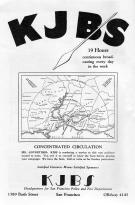
Beginning in December 1929, the station cooperated with the San Francisco Police Department by broadcasting police dispatches to special radio-equipped San Francisco patrol cars. This experimental effort was initially only a part of the all-night “Owl” program.
Harry Wickersham, a former KJBS announcer, recalled that the bulletins were phoned to KJBS from the Police Station and taken down by a sergeant on duty in the studios. The announcer would then interrupt whatever program was on the air by sounding a police siren under his desk, and he would then read the bulletin on the air.
Also in May of 1930, KJBS began cooperating with the Fire Department by broadcasting to fire trucks emergency news and instructions for proceeding to fires. Besides giving listeners a thrill, these efforts proved to be such a great success that the city installed its own two-way police and fire radio system eighteen months later, one of the first cities in the nation to do so.
KJBS achieved several broadcast “firsts.” In 1931, during San Francisco’s Navy Day celebrations, the station broadcast live from a Navy submarine, the U.S.S. Bass, thus becoming the first station to ever broadcast from under water. KJBS broadcast from the first China Clipper as it departed from San Francisco. And, the first AFRA (American Federation of Radio Artists) contract was signed at KJBS.
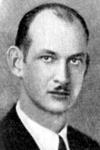
However, KJBS’s most popular contribution to radio was a man named Frank Cope. Cope was probably the world’s first bona fide disk jockey, and his daily five to eight a.m. “Alarm Klok Klub” was San Francisco’s most popular radio program for nearly twenty-five years. Cope, a native of Utah, arrived at KJBS in March 1930 from KLO Radio in Ogden, Utah, and stayed at the San Francisco station until 1959, except for a short hiatus in the early thirties.
Although Arthur Godfrey is often given credit for being the first radio personality to ad lib commercials and kid his sponsors, Frank Cope was doing all this on KJBS in the 1930s. He was elected to the Bay Area Radio Hall of Fame in 2007.
Other popular radio personalities of the time at KJBS included Vic Paulsen, whose afternoon “One O’clock Review” was a housewife favorite from 1931 to 1937. San Francisco’s beloved Dwight Newton, who was then the Examiner’s radio reporter, was heard on the station for a few years, as was Al “The Dunker” Sperry, who was the morning personality during Frank Cope’s brief absence.
KJBS rode the crest of popularity during the thirties and forties, and was one of the few small stations that made money selling to strictly local advertisers.
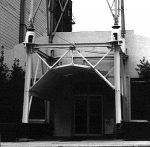
In 1934, KJBS purchased a new DeForest transmitter and increased its power to 500 watts. Shortly afterward, KJBS was permitted to add two more hours of operation, signing on the air at 10:00 p.m. instead of midnight, after WTAM went off the air.
In June of 1934, Ralph Brunton also became a part-owner of KQW in San Jose, and studios for the station were installed in the KJBS building at 1380 Bush Street. A telephone line was installed to allow programs to be simultaneously broadcast on both stations. The stations remained at this facility until February of 1937, when new facilities were built at 1470 Pine Street, adjacent to the recently-completed Willard Battery Shop.
The new studios included three studios, and audio room, two control booths and a master control room. The transmitter was located on the premises, and a new 250-foot self-supporting tower was constructed at the edge of the sidewalk, with the entrance to the station accessed by walking between the tower legs. The top 100 feet of the tower was lit with red neon lights, visible for miles. The station continued to operate from this Pine Street location until the 1970s.
KJBS opened a new FM station, KJBS-FM, in the late 1940s, transmitting from an antenna on the roof of a Nob Hill apartment building. However, early attempts at FM broadcasting proved to be financially costly for all that tried it, and so KJBS-FM was sold a few years later, to become KCBS-FM.
After several decades as one of the Bay Area’s dominant stations, KJBS had lost its momentum by the late 1950s. The all-music format, so unique in the 1930s and ’40s, was now being duplicated by many other stations. KJBS had recently tried just about every known format, from “Top 40” to “Beautiful Music” to classical, all with very little success. When the station was sold to Argonaut Broadcasting in 1960, an idea was devised that, for its time, was revolutionary and untried — the “newspaper of the air.” The station presented continuous news in the style of a newspaper, complete with a sports page, cooking features and a “comics page” (comedy records).
A new directional antenna system was built on the bay shore in Hayward, and the station’s daytime power was increased to 50,000 watts. KJBS became KFAX (“K-Facts”). The entire broadcast industry watched the KFAX experiment with great interest as the station began its new service in May of 1960, the first station in the country to attempt around-the-clock news programming. Unfortunately, by September the station had already lost a quarter of a million dollars. The station decided to drop the all-news format in favor of a sure-fire moneymaker, radio religion.
Just a few years later, a Chicago station, WNUS, took a crack at all-news radio, with more promising results. After that, all-news stations suddenly appeared in every major city, and has since proven to be one of AM radio’s staple formats. San Francisco’s KCBS converted to all-news in the mid-1960s, beginning a successful program service that has lasted over thirty years. KFAX had attempted to emulate a newspaper, while the later efforts at all-news radio developed a product that was more suitable to radio. This may have been the error that KFAX made; or, they may have just been ahead of their time. They found better success with their Christian format, however, which continued uninterrupted for the next 35 years.
FOOTNOTES:
A 1937 history of KJBS, provided by David Ferrell Jackson in 1975 via KFAX Manager Judd Sturtevant.
Interview between author and Vic Paulsen, former KJBS announcer. San Francisco, California, December 9, 1970.
Interview between author and Harry Wickersham, former KJBS employee. San Francisco, California, March 16, 1971.
Interview between author and Dave Crosatto, veteran KJBS/KFAX announcer. San Francisco, California, April 27, 1970.
Obituary of Frank N. Cope, “Fresno Bee,” April 17, 1974.
“San Francisco Examiner,” May 16, 1960.
“First Quarter Century of American Broadcasting,” by E. P. J. Shurick.
The Federal Radio Commission station list, as authorized on 11/11/1928. From research by Barry Mishkind, 1993-94.
![]()

I remember KJBS in the Fifties, when I was in grade school. I’m not sure when the station switched back from 1070 kHz,, but by the time I was old enough to notice such things the station was broadcasting on 1100 kHz. Their musical station I.D. was “Eleven hundred — eleven hundred — KJBS — San Francisco.”
I just found a business card for KJBS (Chuck Pendleton). my mother, Betty June Bump, sang on stations in the 40’s. Someone there may remember her, she was in a wheelchair .. also was active at the USO singing. Is it possible any records are still in your possession?
I am a Brunton. The original KJBS was owned by my father, Sherwood and my two uncles. Ralph Brunton managed the station.
Frances, Ralph Brunton was my grandfather.
My grandfather, Mott Quincy Brunton, was one of the owners of KJBS. I did my surgical specialty training at St. Francis Memorial Hospital between 1975-1978, It was a few blocks from the original garage and radio station KJBS, The antenna still straddled the entrance to the building, although the building no longer had the radio station.
Ralph Brunton was my Grandfather. My mom Marilyn Brunton, had many of the “big star” signed records and autographs.I used to do woodworking projects with my Grandfather in Atherton growing up.
My Grandfather played piano on KFAX under the Detroit Benson show. Mr Benson was walking past my grandparents house in Daly City and heard beautiful piano music. He rang the doorbell and asked my grandfather to come to the station to play on air and do recordings. He was a kind man and would come to the house often, along with his wife and kids for dinner. Sadly Mr Benson died in 1975 in a drowning accident and the show ended and the recordings were never published. I still have the orignal recordings from the show.
That’s a great memory, Annette! We hope you’ll be willing to share copies of those recordings with us.